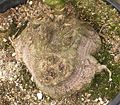| Ploughbreaker | |
|---|---|

| |
| Scientific classification | |
| Kingdom: | Plantae |
| Clade: | Tracheophytes |
| Clade: | Angiosperms |
| Clade: | Eudicots |
| Clade: | Rosids |
| Order: | Fabales |
| Family: | Fabaceae |
| Subfamily: | Faboideae |
| Genus: | Erythrina |
| Species: | E. zeyheri |
| Binomial name | |
| Erythrina zeyheri Harv. | |
| Synonyms | |
| |
Erythrina zeyheri, commonly known as the ploughbreaker, is a deciduous, geoxylic subshrub and member of the family Fabaceae. It is endemic to southern Africa. It grows no more than 60 cm tall and occurs naturally in the higher elevation grasslands of South Africa's central plateau, and that of adjacent Lesotho. They favour deep clay soil in the vicinity of creeks and marshes, and often form colonies. Its specific name commemorates the 19th century botanist, Karl Zeyher.
Description
It is a geoxylic plant, sometimes called an "underground tree", that produces annual stems, some 50 to 60 cm long. It has glabrous, leathery, trifoliolate leaves with large leaflets. The rachis and main leaf venation, which are prominently raised below, are armed with recurved spines on both leaf surfaces. The petioles and stems are likewise armed to discourage browsers. The shoots and leaves are deciduous, dying away during harsh highveld winters, when the plant survives as an extensive woody, tuberous rootstock.
The upright inflorescences appear in summer, with the leaves, from October to January. The drooping scarlet, or rarely white flowers, are capped by a red calyxes. Their fruit are smooth black pods when mature, each containing a few large (1.0 to 1.7 cm long) seeds. These are hard and orange-red in colour.
Foodplant
It is a foodplant for the moth Terastia margaritis.
Gallery
-
 Abaxial leaf surface armed with recurved spines on main veins
Abaxial leaf surface armed with recurved spines on main veins
-
 The perennial tuberous rootstock
The perennial tuberous rootstock
-
 Green pods and seed
Green pods and seed
References
- ^ "Erythrina zeyheri Harv". Plants of the World Online. The Trustees of the Royal Botanic Gardens, Kew. n.d. Retrieved November 27, 2024.
- "Erythrina zeyheri Harv". Catalogue of Life. Species 2000. n.d. Retrieved November 27, 2024.
- ^ Elliot Lithudzha; K Behr. "Erythrina zeyheri". PlantZAfrica.com. South African National Biodiversity Institute. Retrieved 19 December 2012.
- Reports of its occurrence in Botswana and Zimbabwe are suspect, see: "Erythrina latissima E. Mey. (Notes)". Flora Zambesiaca. kew.org. Retrieved 21 December 2012.
- Barras, Colin. "Why some trees evolved to live underground". BBC. Retrieved 27 April 2017.
- ^ Schmidt, Ernst; Lötter, Mervyn; McCleland, Warren (2002). Trees and shrubs of Mpumalanga and Kruger National Park. Johannesburg: Jacana Media. p. 488. ISBN 9781919777306.
- ^ van Wyk, Braam; et al. (1988). Veldgids tot die Veldblomme van die Witwatersrand en Pretoria. Cape Town: Struik. pp. 206–207. ISBN 0-86977-815-3.
- Goff, R. "Terastia margaritis". African Moths. Retrieved 21 December 2012.
External links
- Colony of Erythrina zeyheri after a grass-fire Archived 2012-09-02 at the Wayback Machine, Operation wildflower
![]() Media related to Erythrina zeyheri at Wikimedia Commons
Media related to Erythrina zeyheri at Wikimedia Commons
| Taxon identifiers | |
|---|---|
| Erythrina zeyheri |
|